Eunice and Ron Shanahan have shared with readers of the Victorian Web this material from their website, Letters from the Past. Click on thumbnails for larger images.
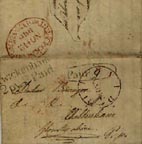 Click
on the image for a larger view
Click
on the image for a larger view
When I saw this letter on a stamp dealer’s table I could not go past it. My particular interest in postal history is of London postmarks, and this one had London Twopenny Post and General Post markings. The one which jumped out and hit me in the eye was the TWICKENHAM postmark. I went to school at Twickenham, so naturally I took a closer look. The letter is dated le 12 Nbre, 1816, and is addressed to Docteur Boiragon etc. etc. etc. Cheltenham, Gloucestershire and is inscribed P.p. signifying postage paid. The postal markings show how it was handled.
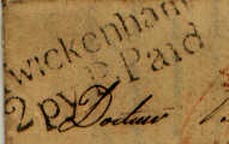 It was handed in at the Twickenham Two Penny Post Office. This was a London Twopenny Post ‘country’ Receiving Office and also a sorting office. It was in the ‘Country’ area lists from 1811. |
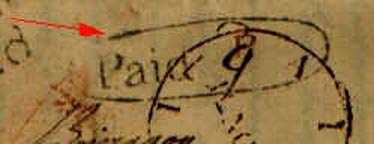 As the General Post was prepaid as well as the local 2p post, the Paid stamp was applied by the Receiving office . The stamp had a space for the correct amount to be entered, in this case '9'. |
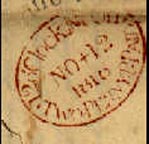
The letter was then despatched to the Twopenny Post in London,where the oval paid date stamp 12 o’clock Noon, NO 12 1816 was applied in orange/red, before transfer to the General Post. In this case (as the month is before the day), it would have been applied at the Chief Office. |
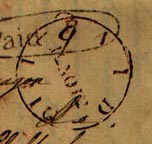
When the letter was received at the Inland section of the General Post the circular Paid Date stamp 12 No 1816 was applied before despatch to Cheltenham. |
The letter is written in French, so it was out with the dictionary, and unlocking memory banks. I was quite excited, thinking that it may have been something of State importance, an insight into the politics of being an emigrée after the battle of Waterloo. But no, it was not national security involved - but a very detailed description of the lady’s digestive problems. The letter begins,
"When I left Cheltenham, Doctor, you asked me to give you my news at the end of two months. I found myself so well, from your kind care, that I can do so with pleasure and complete trust. Since then, I have followed exactly the regime and treatment which you prescribed for me and I found myself infinitely better for some months but, for the last fortnight, despite following the same regime and treatment, I have not been nearly as well, and I have returned to the state you saw me in, when I arrived at Cheltenham."
There are a few more sentences, giving detailed descriptions of her tummy troubles, the least graphic of which are:
"When I take no salt or pills, my digestion is not good. I become yellow again, for several days, in particular my balance is not good, I have much trouble in getting to sleep. This morning my head was spinning, and I had a heavy head. I was grubby, uncomfortable and had no appetite, in a word, I was what you would call "languid"
and then she closes the letter with:
"Now that I have given you the details of what I suffer and my observations, I put myself entirely in your hands again, and I will do exactly what you advise. My belief in you is complete, I always think of you with gratitude and appreciation of the interest that you have shown to me, and for the care that you have had for me, for which I am so grateful, believe me, my dear Doctor, that I will never forget it and that I am very pleased to have this occasion to give you my renewed assurances. Please give my regards to your delightful children, I hope that they are well. My brother, as well as the Comtesses of Verac and Mountjoy send their compliments
your affectionate
Louise A.E. D’Orléans"
Not only does the letter have four really clear postal markings, but the letter
is sealed with an impression of a crest. It is a very clear and detailed impression
of an oval shape with a diamond inside it. On the diamond is a crown with five
fleur-de-lys, there is a sign like a letter 'T', which I understand signifies
the cadet branch of the family, and then three fleur-de-lys. This looks like
the D’Orléans family crest. When I saw the signature of the letter,
it seems that was correct. Yours affectionately ‘Louise A.E. D’Orleans’.
I am indebted to Bob Williams of W. A., and Dr. Cashmore of the Twickenham Local
History Society, for advice regarding this lady.
It is difficult to be sure, because the signature is the wrong way around, but it seems likely that this is the sister of the Duke of Orléans who became King of the French in 1830. Her name was Adelaide Eugenie Louise, and she was a devoted admirer and supporter of her brother, and lived much of her adult life with him and his family. The records show that she certainly was living with the family in Orleans House Twickenham during their stay in 1815-1817. The Orléans family had close links with Twickenham and the Duke of Orléans stayed there during the years 1815-1817. The Twickenham local history group have produced a booklet The Orléans family in Twickenham 1800-1932, showing that his sister and his mother visited him there, when they stayed at what is now called Orleans House, (in my days this was a school - but at that time I paid no attention to history, and would not have registered the link with the French Royal Family). As a matter of interest, if this is Adelaide Eugenie Louise D’Orléans, she lived until 1847, so her doctor’s regime and pills would seem to have worked.
These old letters seem to put me in touch with life as it was - much more effectively than a factual history textbook. It is not a surprise to know that lifestyles have altered over a period of 180 years, but in fact things change quicker than that. For instance, I well remember that the school I attended (a good few years ago), was an all-girls school, and when the Rugby Union International matches were held at the Twickenham ground we were given the half day off so that we did not come into contact with all those rough male spectators. Nowadays, my niece plays rugby football!
Last modified 18 December 2002